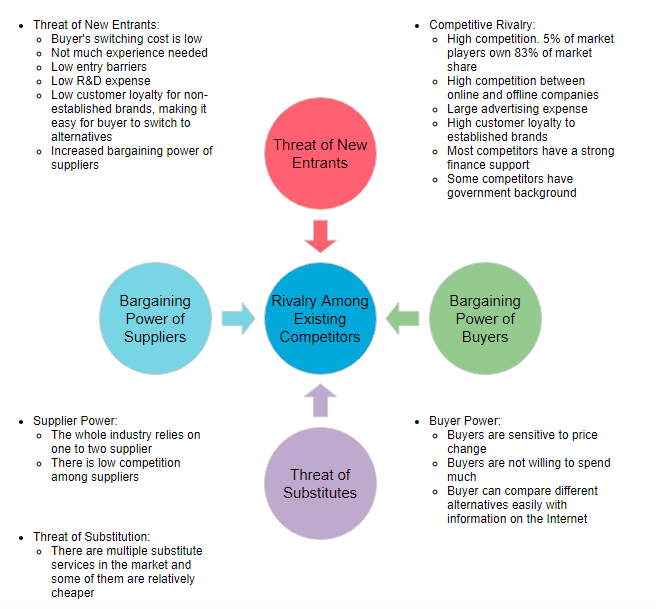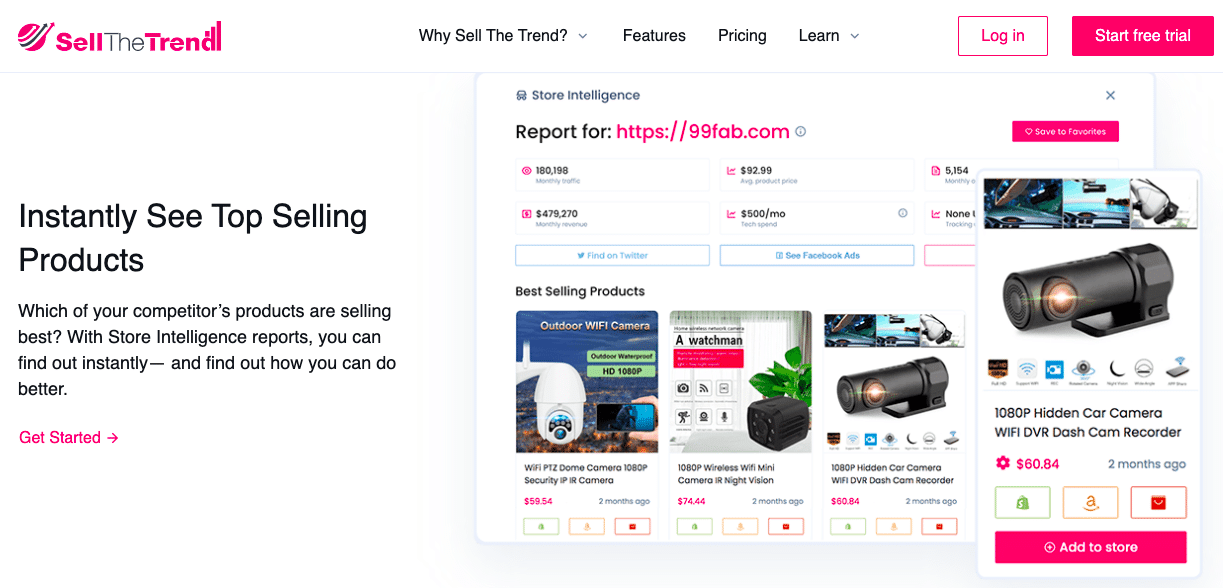How to Conduct an Ecommerce Competitor Analysis: Dropshipping Edition
Contents
Over the past two years, the Covid-19 pandemic has thrust eCommerce into the spotlight and made it an absolute necessity for many brands, corporations, retail stores, and even small businesses. Many sub-industries such as dropshipping now look almost unrecognizable from what they looked like before the pandemic.

Because of the relatively low barriers of entry, dropshipping has attracted a huge number of people, which therefore means more and stiffer competition. This isn’t a bad thing, not nearly as much. The potential eCommerce market is huge and if you pick the right products to focus on, you can make a neat profit.
Therefore, running an eCommerce competitor analysis is crucial at any stage of your dropshipping business. You will need to occasionally snoop in on what your competition is doing to establish what they are doing right, what they are not doing right, and the potential market opportunities you can target to differentiate yourself.


Here are some more reasons why an eCommerce competitor analysis can set your dropshipping business on a path of success:
- Your competition will reveal what’s possible
Your biggest competitors will usually have been around for a longer period and achieved more than your business. But this also means that at some point, they were in the exact same position. Instead of regarding your biggest competitors with trepidation and anxiety, look at them as living proof that you too can achieve the same amount of success if not more.
- Proof that markets exist
You should be wary of markets that don’t have any form of competition. While it may feel grand to want to be the first one to serve a particular market, it’s statistically unlikely that you will blaze new trails. After all, you are selling products that already exist and there are probably other suppliers trying to fulfill existing demand.
Your competition, and particularly their success, is proof that a market exists and that there’s a sizable chunk of demand for the products. A market with good competition also means that it’s huge enough to support several businesses over the years. The pie is big enough to sustain several people and you absolutely can and must stake a claim.
- You can learn different pricing and business models
If you are just launching your eCommerce store, you can pick valuable insights from your competition. They have already done all the experiments over the years and found what works for them. Use their experiences as the foundation for your own pricing and business models.
What is a Competitor Analysis?
While market research helps you find potential customers for your business venture, a competitor analysis helps your business to find ways in which it can build a competitive advantage within an existing market by analyzing other businesses already competing for your potential customers.
It’s virtually impossible for you to differentiate your dropshipping business, for instance, without first analyzing and uncovering your competition’s strategic activities. A competitive analysis isn’t just a quick peek at your competitors’ websites and their social media activities. It’s about gathering the necessary intelligence that will inform your strategic plan on how you can capitalize on their weaknesses and market gaps.
Harvard Professor Michael Porter presented five key forces that can provide an overview of a market and help businesses assess potential areas they can develop competitive advantages:

Therefore, a competitor analysis can also help you establish any unique or improved aspects of your own eCommerce business, which you then can play up to attract your target customers within an existing market.
Of course, this is a lot of work, particularly if you are just starting out or you are wondering how you can take your eCommerce business to the next level. Read on to learn a simple approach to conducting an effective eCommerce competitor analysis, and a tool you can use to get the best results and save you a great deal of valuable time.
How to Conduct an Ecommerce Competitor Analysis
You may have come across this famous Isaac Newton quote: “If I have seen further than others, it by standing on the shoulders of giants.” This is precisely what an eCommerce competitor analysis entails; developing winning strategies for your business on the foundation of what other businesses have already achieved.
At the risk of sounding too simplistic, we are going to go ahead and state that an eCommerce competitor analysis could be whittled down to a case of who, what, where, and how. Here are four steps you can take to do an eCommerce competitor analysis that would give you a solid foundation for ideas on how to outdo your competition :
Step 1: Determine your competitors

The first, and perhaps the most crucial step, is to establish who you are competing against. Only then can you gather useful information and insights that you can use to compare your business. At this stage, you are seeking to answer the fundamental question: if your potential customers didn’t buy from you but still bought the same products, where would they turn?
There are several ways to do this, and they include searching from your product categories on Google and exploring the results. Keep this list short, ideally less than 10 competitors. Depending on the results, you may have to split this list into categories:
- Direct competitors – stores that sell similar products and target the same audience.
- Indirect competitors – stores that sell different products (alternatives, substitutes, etc. that serve the same need) in the same category but target the same audience.
Once you have created your list, gather more information about them to get a clear picture of who they are and keep them on your radar. Monitoring your competition can eat up a lot of your time that would otherwise be spent on other aspects of growing your business. Therefore, it’s more prudent to monitor your biggest competitors rather than all the businesses that offer similar products.
Step 2: Determine your competitors’ product offerings
All businesses are built around one or more products and services. Analyze your competitor’s product lines, pricing, and any kind of offers or discounts they give to their customers. Establish how they differentiate themselves in terms of pricing, shipping, product features, or any other product offering strategy in use. Find out the various benefits, functions, value-adds, and key features they focus on.
You can also glean valuable information from their customer’s feedback. Check out customer reviews to establish the most appealing aspects of their products and the various aspects upon which they heap praises. Take note of their pain points as well and areas of weaknesses, particularly the recurring ones.

Single out customers that have provided less than 5 stars feedback and look out for any consistent complaints or themes. For instance, they may express a similar concern (such as long shipping periods, packaging, or pricing) using different words. Map out any consistent themes.
Step 3: Establish where your competitors are selling
The next step is to find out where all the businesses on your list are selling. The simplest way to do this is to perform a Google search and take note of the marketplaces, platforms, websites, and other places they list their products.
Learning where your competitors sell their products will provide valuable insights on where you should list your own products. You may even discover that there are a bunch of different places you hadn’t considered, or better yet some new opportunities you may want to explore.
Therefore, an eCommerce competitor analysis can be a powerful and enlightening activity, particularly if you are just setting up. You may not even have to do anything new in those first few stages when are trying to get a footing.
Step 4: Establish how your competitors are selling
The final major step is to determine the strategies that all the eCommerce stores on your list are using. Markets and product categories differ and it’s not always just about offering a particular range of products but how they are offered or presented to the market.
Some will have an enormous amount of competition while others will low competition and it’s incredibly important that you establish how your competition offers its products to market. For instance, you want to establish the following:
- What kind of shipping options do your competitors provide (expedited shipping, one-day shipping, free shipping, standard shipping, cost of shipping, etc.)
- What are their selling policies? (return policies, warranties, etc.)
- What kind of customer service communication options do they give their buyers? (live chat, phone, email, etc.)
Gather as much information as you can about how they present their products, look for commonalities as well as gaps and try to establish creative ways you can fix the gaps or add more value without having to spend too much money.
Be careful not to reinvent the wheel here. Your competitors may already have tried and tested approaches that have gained considerable traction with your kind of audience. In this case, you may be better off, at least in the meantime, be better off building upon these approaches.
Ready to get started?
As you can already imagine, conducting a proper, accurate, and actionable eCommerce analysis isn’t easy. But the good news is that tools such as Sell The Trend can take the legwork out of the process.

With powerful and unique features such as store intelligence, Sell The Trend can instantly transform into your own personalized spy network. Using A.I. powered algorithms, Store Intelligence will instantly provide unmatched insights on your competition as well as detailed data on orders, pricing, revenue, traffic, and so much more so you can smart marketing decisions to take your dropshipping business to the next level.
Despite the complex A.I. algorithms that power it, the Store Intelligence feature has an easy-to-use interface. It works by simply entering a store’s URL and instantly getting a comprehensive and detailed report on all the crucial business metrics you need to make the right marketing decisions and leapfrog your competition.
Sell The Trend also has a ton of other features and tools that can power your dropshipping store to the next level. It comes preloaded with tools to help you pick winning products and easily push them to your dropshipping store, find and connect to the right suppliers, simplify the management of your store’s operations, and a wide range of marketing and social media tools to promote and grow your eCommerce store.
Conclusion
Analyzing and understanding your competition will give you a vantage point from which you can build a successful dropshipping business. It can be as simple as building on your competitors’ successes and at the same time, avoiding their failures.
Are you ready to outgun your competition? Get a free, no-commitment 7-day trial of Sell The Trend and get the full experience of an all-in-one dropshipping platform.








